
You're here: MibSAR's home page :: Volunteer requirements page
Michigan Backcountry Search
and Rescue (MibSAR)
LRSOG volunteer requirements
|
By
Michael Neiger Marquette, Michigan © Copyright 2012-2016 |
| Notice: MibSAR is not currently seeking volunteers |
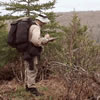 |
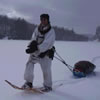 |
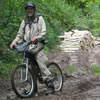 |
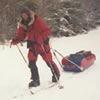 |
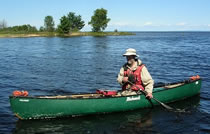 |
|
Michael Neiger occasionally seeks a very-fit, non-smoking volunteer or two to work with him during his special operations group (SOG) investigations and field operations.
SOG operators are hard-core, dyed-in-the-wool bushmen/women who thrive in remote, inhospitable wilderness. Since they frequently work the bush fully equipped and provisioned for long-range operations—without support or resupply for up to 10 days at times—Michael Neiger's SOG is considered a heavy team by conventional SAR standards.
- SOG operators work in the remote bush between the Great Lakes in Northern Michigan, USA, and the Arctic Ocean's Lower Hudson Bay (James Bay) in Northern Ontario, Canada.
- SOG operators typically live out of a rucksack, mountain-bike pannier, cargo sledge, or canoe for days—sometimes weeks—at a time.
- SOG operators conduct arduous, long-range, freestyle recon; game trail, scent post, scat deposit, feeding area, and den site recon, metal detecting, and sifting; wide-area grid searches; and difficult searches of very-challenging swamps, marshes, semi-mountainous terrain, and waterways.
- SOG operators conduct physically-demanding operations that usually involve humping rucks with full, multi-day loads; working long days; and bivouacking in place when the sun sets.
Tobacco & alcohol
SOG operators must be:
• None-smokers/chewers
• Alcohol-free during operations
• Drug-free at all times
 |
 |
 |
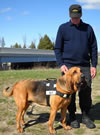 |
 |
 |
 |
 |
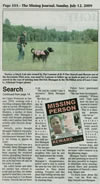 |
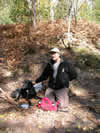 |
 |
 |
 |
 |
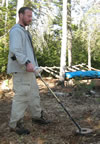 |
 |
 |
 |
 |
 |
 |
 |
 |
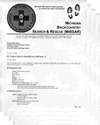 |
 |
 |
 |
 |
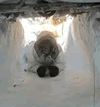 |
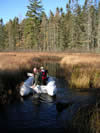 |
 |
Physical fitness
is much the same as another,
and that he [she] is best
who is trained in the severest school.
—Thucydides, Greek General, 460-400 B.C.
History of the Peloponnesian WarSOG operators must be very physically fit—both aerobically and muscularly—since their wilderness operations are strenuous, prolonged, and unsupported.
They must be fit enough to hump a heavy rucksack hour after hour, day after day, under difficult environmental conditions such as extreme heat or cold, high winds, steep terrain, tangled bush, marshes, swamps, unstable ground, slippery terrain, deep snow, ice, etc., without undue fatigue, without becoming a hazard to themselves or others, and with enough reserve to deal with unforeseen emergencies.
Minimum physical requirements:
• Must train strenuously on a near-daily basis
• Must be able to run 6 miles without difficulty or undue fatigue
• Must be able to swim 1 mile without difficulty or undue fatigue
Spotless criminal histories
SOG operators must have spotless criminal histories and very good driving records.
• To get a criminal history check completed, contact Michael Neiger.
Wilderness backpacking experience
SOG operators must be fully-equipped, 4-season, foul-weather backpackers with lots of experience hiking, bushwhacking, navigating, and bivouacking off-trail.
In-pocket survival kits
SOG operators must agree to have the following essential survival items on them 24/7, which means even when bivouacking.
• Waterproof lifeboat matches in container attached to loss-prevention lanyard
• Waterproof, spark-ignitable firestarters in container attached to loss-prevention lanyard (you can soak these in water, pull the fibers apart, and light them with a spark, no flame needed like a lot of other firestarters)
• Adjustable-flame lighter
• Magnesium firestarter attached to loss-prevention lanyard
• Sturdy, lock-blade pocket knife attached to loss-prevention lanyard
• Very-small, good-quality backup micro-compass attached to loss-prevention lanyard
• Loud, high-quality whistle attached to loss-prevention lanyard
• Signal mirror attached to loss-prevention lanyard
• Very-small, high-quality micro-flashlight attached to loss-prevention lanyard
• 60" by 96" 3.2 ounce SOL emergency blanket/shelter with four 4' lengths of 1.5 mm cordage in a plastic zip-lock bag attached to a loss-prevention lanyard with duct tape
• Stout fixed-blade knife in belt-mounted drop-sheath (must carry/ride below rucksack waistbelt). Essential for quickly harvesting boughs for an insulated bed and shelter roof, as well as splitting ice-encrusted logs down to their dry heartwood for a life-saving fire.For maximum carrying comfort and security against loss, distribute survival items among pockets in loose-fitting, multi-pocketed pants, making sure each respective lanyard is looped though a small lanyard loop hand-sewn into each pocket.
Subdued clothing & gear
Since at least half of SOG operations and investigations are criminal in nature—with some involving illegal drugs, weapons, foul play, homicide, and clandestine burial sites—and often require work in remote, seldom-traveled areas that poachers, marijuana growers, malcontents, miscreants, and other unfriendlies call home, all operational clothing, rainsuits, rucksacks, bivouac sacks, tarps, etc. must be low-profile in outward appearance.
Subdued colors such as brown, tan, gray, green, and black are acceptable colors; bright, attention-grabbing colors such red, yellow, orange, pink, and blue are not acceptable.
Heavy, military camouflage should also be avoided as it creates its own set of problems in encounters with law-abiding civilians.
If bright-colored clothing is needed for certain situations, such as line searches, or when working with traditional search-and-rescue teams, high-visibility vests, hats, and pack covers can be donned.
No cotton or down clothing and gear
SOG operators work around and in water, in rainy and wet-snow weather, and hard enough to soak their clothing in sweat, so they must agree to not carry or wear cotton or down clothing and gear.
Improvised PFD
SOG operators often ford or swim waterways, some of which may require up to a half-hour or more of swimming, and must agree to carry a full-length, closed-cell sleeping pad, or two half pads—not an inflatable pad—that can be rolled up and tied to form an improvised portable flotation device (PFD) as needed.
No ground fires
SOG operators must be able to cold-camp—bivouac, rest, and search—using just their body heat, clothing, and gear, without auxiliary heat sources, including ground fires, except in an emergency. They must agree to:
• Cook and boil water with a NATO solid-fuel tab stove, white-gas stove, compressed-gas stove, etc.
• No hobo or twig burning stoves are allowed when the bush is snow free.
• No ground fires are permitted. Small fires atop a steel cookie sheet supported off the ground on a couple logs are permitted in the winter in certain situations.
Low impact travel & bivouacking
SOG operators frequently work in pristine areas, and they must be adherents to the low-impact ethos, which means bushwhacking and bivouacking: without campfires, without cutting green vegetation and trees, burying all waste and toilet paper, restoring bivouac sites to the state they were found in, and packing out everything packed in.
Gear and ration caching rope
SOG operators must agree to:
• Carry a 40-foot chunk of 1/8-diameter slippery rope for hanging/caching gear and rations from roving wolves, bears, and other animals, both when bivouacking at night and when searching out a basecamp or cache during the day.
Expenses
MibSAR is an all-volunteer, no-budget organization, one in which each SOG operator covers all of his or her own expenses for clothing, gear (including skis, snowshoes, off-trail cargo sledge, mountain bike, mountain bike trailer, and Royalite solo canoe), fuel, rations, travel expenses (vehicle, gas, lodging, meals, train fare, plane fare, shuttle fare), permits, insurance, etc. MibSAR has no budget, and it does not solicit donations or conduct fundraising drives.
Fluid deployments
Due to the number of cases SOG operators work on, and the variability of several factors, including weather, flooding, access to private property, directives from an agency of jurisdiction, logging operations, road closures, etc., most SOG deployments are fluid in nature, with areas of operation determined on-site, once they get boots on the ground, and in consideration of the latest intel, including tips and new areas of interest.
Response requirement
Since MibSAR works primarily on cold cases, most deployments are planned, multi-day, wilderness operations.
SOG operators must be willing and able to commit to several, multi-day, weekend-centered missions per year, all involving considerable travel in Northern Michigan. Much longer duration Expeditionary SAR Operations may also be conducted several times each year in the Canadian bush.
Paperwork
SOG operators must sign
• a liability waiver
• a confidentiality agreement
Training
and stronger than you seem,
and smarter than you think.
—Christopher Robin, fictional character in Winnie-the-Pooh,
created by English author Alan Alexander Milne, 1882-1956As a multinational, civilian-based, volunteer special operations group (SOG), one with volunteers located 100s of miles apart, MibSAR's training recommendations are designed to be met within a volunteer's local community, by drawing on local experts and organizations, online, or through self-study. Volunteers must be willing and able to commit to considerable training and study demands on an ongoing basis.
While not required, it is recommended that SOG operators seek out SAR-related training, including, but not limited to:
• SAR training: SOG operators should consider purchasing NASAR's Introduction to Search and Rescue (ISAR), completing this self-study course, and taking the 75-question online test to become certified as a NASAR SARTECH III. Pay the additional money to get the certificate.
• First-aid training: SOG operators should consider completing a wilderness first-aid course. Keep the certificate.
• CPR training: SOG operators should consider completing a CPR course. Keep the certificate.
• Bloodborne pathogens training: SOG operators should consider completing a bloodborne pathogens training program, such as the free online course offered by Michigan State University. Keep the certificate.
• Land navigation: SOG operators should consider taking an advanced land navigation course. A good, basic, self-study manual can be downloaded here.
Integrity and character
SOG operators must be extremely honest and discrete since they regularly work with grieving family members, over-worked law enforcement investigators, prosecutors, judges, defense attorneys, witnesses, informants, potential suspects, government officials, members of the media, private property owners, personal property, public property, state artifacts, sensitive information, human remains, and forensic evidence—which will be analyzed by the Federal Bureau of Investigation (FBI) Crime Laboratory, Michigan State Police Forensic Crime Laboratory system, and some of the Midwest's top forensic experts.
Law-enforcement friendly
SOG operators work hand-in-hand work with local, county, tribal, state, and federal, and international law enforcement officers and investigators and must be very law enforcement friendly.
Specialized equipment
In addition to the general gear loadout listed below, SOG operators must carry
• a stand-alone GPS unit (not a phone-based GPS unit)
• a 5-watt GMRS handheld radio, preferably a water-resistant Midland GXT 2000VP4
Standard 3-season foul-weather SOG loadout
SOG operators must have a bomb-proof, 3-season, foul-weather ruck loadout...
|
Field ruck loadout
|
|
|
Water stores |
|
| Vehicle equipment |
|
| Vehicle safety checks |
|
More information about volunteering
If you're a discreet, mature, nonsmoking, physically-and-mentally-robust outdoor enthusiast with a resilient spirit and lots of 4-season, all-weather, off-trail, wilderness backpacking experience, feel free to contact Michael Neiger of Marquette, Michigan to learn more about volunteering as an SOG operator with Michael Neiger.
Return to top of page :: Return to home page
In God's wilderness
lies the hope of the world,
the great, fresh, unblighted,
unredeemed wilderness.
— John Muir, 1838-1914
Alaska Wilderness, 1890
If you've been able to read this Web page...
thank a Teacher;
If you've been able to read this Web page in English...
thank a Veteran.
—Author unknown• Copyright notice •
Content Copyright © 1984 — 2020-01-18
by Michael A. Neiger
• All rights reserved •
No part of this Web page or this Web site protected by copyright law may be reproduced, transmitted, or used in any form—including graphic, electronic, Web, mechanical or other form—or by any means—including photocopying, recording, taping, Internet distribution, information storage retrieval system, or by other means—for any purpose, except by a reviewer, who may quote brief passages, without the prior, express, written permission of the author.Comments? Suggestions?
Dead links? Inaccurate info?
Contact the WebMaster, Michael A. Neiger, at mneiger@hotmail.comWeb site URL: www.MibSAR.com
Return to top of page :: Return to home page
You're here: MibSAR's home page :: Volunteer requirements page